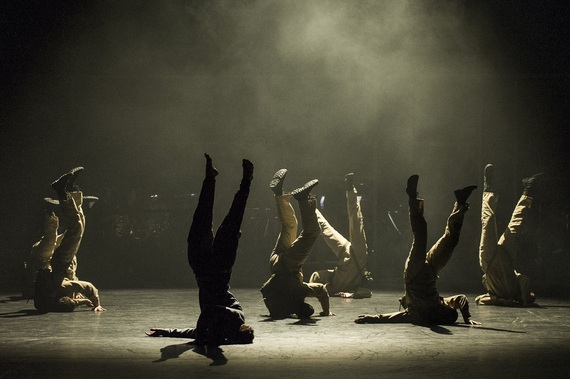The advent of mechanical weaponry in World War I literally took warfare out of human hands, and in so doing, took its effects beyond human comprehension. Now as then, the arts play an important role in re-humanizing war by infusing it with some of the blood lost in battle.
The most kinesthetic of art forms, dance is particularly well suited to conveying the war's physical, emotional and mechanical dimensions, and in Iván Peréz' "Young Men," now running at Sadler's Wells, the BalletBoyz boldly take on this endeavor. Inspired by the experiences of the soldiers on the frontlines, "Young Men" waxes indulgent at times, but still offers a compelling portrait of men pushed to their absolute limits.
Consisting of ten men and two female guest artists, the company itself is extraordinary. The selflessness and totality with which they give themselves to the work makes it clear how wholeheartedly they believe in it, making them convincing as the soldiers they are meant to portray.
The work is set to an original score by Keaton Henson, which combines heavy strings and percussion with recordings of bells, sirens and warplanes. Mirroring the choreography, the music includes a few quieter and reflective interludes, but generally favors testosterone-fueled power. Subtle, this work is not.
Peréz' choreography is similarly intense, pushing the extremely fit dancers to the edge of their strength and stamina. Earthbound spins and tumbles explode into vertiginous jumps, while themes of support and strife unfold through frequent lifts and confrontations.
A program note indicates that "Young Men" was originally meant to be a shorter work and arguably, it should be. However rich its subject matter, the choreography sometimes appears to exploit it as a virtuoso showcase, with hints of action-film gloss and glory. Overall, though, the choreographic narrative shows clear reverence for its inspiration: in a scene depicting an excruciating military drill, a soldier gradually falls apart, even as he unquestioningly obeys his orders. In another, two lovers reunite briefly on the frontlines before being ripped apart again by the war.
After a game of cards turns violent, another soldier's PTSD, movingly portrayed by Matthew Rees, has tragic consequences. And most heartwrenchingly, a stripped and raw Andrea Carrucciu writhes in shellshocked horror, only to be dressed by his comrades to relive his nightmare in the trenches.
For all its moving material and beautiful dancing, the evening left me emotionally underwhelmed (unlike "Lest We Forget," English National Ballet's WWI commemorative, which didn't leave a dry eye in the house when it ran last month). At least for me, the relentlessness of both the music and dancing in "Young Men" left too little space for catharsis. Still, "Young Men" speaks to the big ambitions of both the young company and the 31-year-old choreographer. With time, maturity and perhaps a touch of restraint, I'm confident they'll both realize them fully.
"Young Men" runs at Sadler's Wells in London until October 10, 2015. For tickets and more information, visit www.sadlerswells.com.

